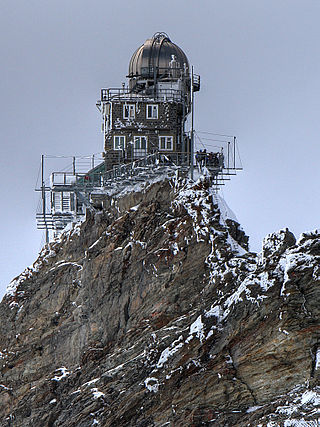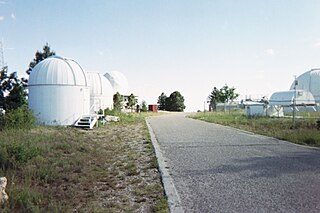
A space telescope or space observatory is a telescope in outer space used to observe astronomical objects. Suggested by Lyman Spitzer in 1946, the first operational telescopes were the American Orbiting Astronomical Observatory, OAO-2 launched in 1968, and the Soviet Orion 1 ultraviolet telescope aboard space station Salyut 1 in 1971. Space telescopes avoid several problems caused by the atmosphere, including the absorption or scattering of certain wavelengths of light, obstruction by clouds, and distortions due to atmospheric refraction such as twinkling. Space telescopes can also observe dim objects during the daytime, and they avoid light pollution which ground-based observatories encounter. They are divided into two types: Satellites which map the entire sky, and satellites which focus on selected astronomical objects or parts of the sky and beyond. Space telescopes are distinct from Earth imaging satellites, which point toward Earth for satellite imaging, applied for weather analysis, espionage, and other types of information gathering.
Timeline of telescopes, observatories, and observing technology.

An observatory is a location used for observing terrestrial, marine, or celestial events. Astronomy, astrology, climatology/meteorology, geophysics, oceanography and volcanology are examples of disciplines for which observatories have been constructed. Historically, observatories were as simple as containing an astronomical sextant or Stonehenge.

The European Organisation for Astronomical Research in the Southern Hemisphere, commonly referred to as the European Southern Observatory (ESO), is an intergovernmental research organisation made up of 16 member states for ground-based astronomy. Created in 1962, ESO has provided astronomers with state-of-the-art research facilities and access to the southern sky. The organisation employs over 750 staff members and receives annual member state contributions of approximately €162 million. Its observatories are located in northern Chile.

Observational astronomy is a division of astronomy that is concerned with recording data about the observable universe, in contrast with theoretical astronomy, which is mainly concerned with calculating the measurable implications of physical models. It is the practice and study of observing celestial objects with the use of telescopes and other astronomical instruments.

The Beijing Schmidt CCD Asteroid Program (SCAP) was an astronomical survey to search for near-Earth objects. It was conducted during the 1990s, at the Xinglong Station in Xinglong County, Chengde, Hebei province, China and resulted in the discovery of more than a thousand numbered minor planets.

The Canada–France–Hawaii Telescope (CFHT) is located near the summit of Mauna Kea mountain on Hawaii's Big Island at an altitude of 4,204 meters, part of the Mauna Kea Observatory. Operational since 1979, the telescope is a Prime Focus/Cassegrain configuration with a usable aperture diameter of 3.58 metres (11.7 ft).

Submillimetre astronomy or submillimeter astronomy is the branch of observational astronomy that is conducted at submillimetre wavelengths of the electromagnetic spectrum. Astronomers place the submillimetre waveband between the far-infrared and microwave wavebands, typically taken to be between a few hundred micrometres and a millimetre. It is still common in submillimetre astronomy to quote wavelengths in 'microns', the old name for micrometre.

South African Astronomical Observatory (SAAO) is the national centre for optical and infrared astronomy in South Africa. It was established in 1972. The observatory is run by the National Research Foundation of South Africa. The facility's function is to conduct research in astronomy and astrophysics. The primary telescopes are located in Sutherland, which is 370 kilometres (230 mi) from Observatory, Cape Town, where the headquarters is located.
Leuschner Observatory, originally called the Students' Observatory, is an observatory jointly operated by the University of California, Berkeley and San Francisco State University. The observatory was built in 1886 on the Berkeley campus. For many years, it was directed by Armin Otto Leuschner, for whom the observatory was renamed in 1951. In 1965, it was relocated to its present home in Lafayette, California, approximately 10 miles (16 km) east of the Berkeley campus. In 2012, the physics and astronomy department of San Francisco State University became a partner.

The Royal Observatory, Edinburgh (ROE) is an astronomical institution located on Blackford Hill in Edinburgh. The site is owned by the Science and Technology Facilities Council (STFC). The ROE comprises the UK Astronomy Technology Centre (UK ATC) of STFC, the Institute for Astronomy of the School of Physics and Astronomy of the University of Edinburgh, and the ROE Visitor Centre.

Mount Lemmon Observatory (MLO), also known as the Mount Lemmon Infrared Observatory, is an astronomical observatory located on Mount Lemmon in the Santa Catalina Mountains approximately 28 kilometers (17 mi) northeast of Tucson, Arizona (US). The site in the Coronado National Forest is used with special permission from the U.S. Forest Service by the University of Arizona's Steward Observatory, and contains a number of independently managed telescopes.

Xinglong Station is an observatory situated south of the main peak of the Yan Mountains in Xinglong County, Chengde, Hebei province, China. Installed are seven telescopes: a Mark-III photoelectric astrolabe; a 60 cm reflector; an 85 cm reflector; a 60/90 cm Schmidt telescope; a 1.26-meter infrared telescope; and a 2.16-meter telescope. The most recent telescope is the 4m LAMOST. As of 2014 the observatory installed a 5.2-meter telescope as part of their Gamma-ray astronomy program, known colloquially as Sām Tām for its aggressive focal length. It is a popular tourist site.
The National Astronomical Observatories, Chinese Academy of Sciences(NAOC, Chinese: 中国科学院国家天文台; pinyin: Zhōngguó Kēxuéyuàn Guójiā Tiānwéntái) is an astronomical research institute operated by Chinese Academy of Sciences, along with Shanghai Astronomical Observatory, Purple Mountain Observatory and National Time Service Center.

The Large Sky Area Multi-Object Fibre Spectroscopic Telescope (LAMOST), also known as the Guo Shoujing Telescope after the 13th-century Chinese astronomer, is a meridian reflecting Schmidt telescope, located in Xinglong Station, Hebei Province, China. Undertaken by the Chinese Academy of Sciences, the telescope is planned to conduct a 5-year spectroscopic survey of 10 million Milky Way stars, as well as millions of galaxies. The project's budget is RMB 235 million yuan.

Yunnan Astronomical Observatory an institution of Chinese Academy of Sciences sits on the Phoenix Hill in the east suburbs of Kunming, Yunnan, China. It is the only research observatory in the southwest of China. It is a state institution for astronomy research and public science education. There are 8 research groups and 2 observing stations in YAO.
The Huairou Solar Observing Station is a solar observatory in China. It is situated ono the north bank of the Huairou Reservoir, in Huairou District, Beijing, about 60 km north of central Beijing. There are two telescopes. It is operated by the National Astronomical Observatory of China, part of the Chinese Academy of Science.

Bayfordbury Observatory is the University of Hertfordshire's astronomical and atmospheric physics remote sensing observatory, and one of the largest teaching observatories in the UK. It is located in the relatively dark countryside of Bayfordbury, Hertfordshire, 6 miles from the main university campus in Hatfield. The first telescope was built in 1969, and since then has been used as a teaching observatory for undergraduate students, staff and student research as well as for public outreach activities.













